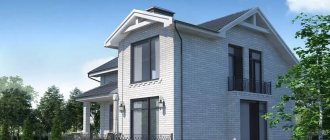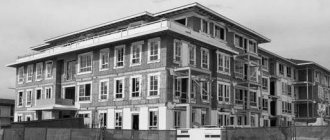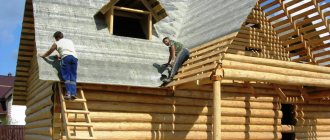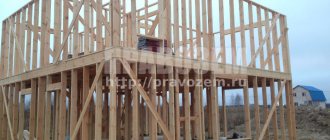Low-rise construction is one of the key factors in the integrated development of territories and one of the main directions of state policy in the Russian Federation. According to forecasts of the Russian Government, the share of housing of this type should exceed 70% by 2021. It is expected that the development of low-rise construction (LLC) will contribute to the overall economic growth of the country by creating millions of jobs in the field of construction, finishing works, in the construction materials market and in the field of specialized services.
Purpose and use of the land plot
The construction of low-rise construction projects is closely related to the types of permitted use of the land.
The town planning regulations define the basic land use rules:
- the purpose of land near a low-rise residential building can be determined for running personal subsidiary plots;
- It is allowed to place garages, other ancillary buildings, gardens and vegetable gardens on the site;
- land for blocked development is suitable for the construction of a residential building up to 3 floors high, intended for permanent residence, but not divided into apartments. The property may have a common wall with neighboring residential buildings, but the total number of semi-detached houses cannot exceed 10;
- on a land plot for low-rise residential development there may be mobile housing (camping, tent city, trailer, trailer), which can be connected to utilities passing through this territory.
Basic Concepts
To date, there is no clear definition of low-rise construction in the Town Planning Code of the Russian Federation (GrK RF). There are only a few clarifications that can indirectly be attributed to this issue:
- description of the procedure for obtaining a construction permit in Art. 51;
- a mention of residential buildings with a height of no more than 3 floors (residential buildings of blocked development) and of detached capital construction projects with a height of no more than 2 floors, which do not require an examination, in Art. 49;
- allocation of low-rise buildings as part of residential zones in Art. 35.
Order of the Ministry of Economic Development of the Russian Federation No. 540 dated September 1, 2014, which provides factors for classifying land plots by type of permitted use, helps clarify the concept. The document states that low-rise residential development is the construction of a residential building with a height of no more than 3 above-ground floors, suitable for permanent residence and not intended for division into apartments. The definition of the Ministry of Economic Development of the Russian Federation should not be confused with the provisions of the Town Planning Code. In the Ministry's document, only above-ground floors are indicated as the main feature, and in the Civil Code of the Russian Federation - the total number of floors, including underground ones. However, today the construction industry has developed its own unofficial definition of a low-rise building. Low-rise buildings include houses up to 4 floors inclusive without an elevator and garbage chute. In rare cases, even a building with 5 floors may be included there.
Prospects for the construction of low-rise buildings
Not so long ago, the construction of low-rise buildings was mainly carried out in urban settlements, but today the relevance of this housing has reached its peak. Development companies began to quickly develop their activities in providing services for the construction of low-rise buildings, and this primarily depends on the low cost of constructing this type of housing. This also affected the demand among real estate buyers, because a cheap country house becomes a real chance to leave the “concrete jungle” and enjoy life among nature.
Mostly low-rise buildings gained their popularity in the suburban area. They are a place to relax and are preferred by those who are tired of the bustle of the city. In addition, low-rise buildings can be a good solution for those who do not have enough money to buy an apartment in the city. Individual cottages or complexes of low-rise buildings are the most profitable option for purchasing real estate during a crisis situation in the country. In addition, the demand for low-rise housing is so great that its construction is one of the main tasks assigned to state developers.
Due to the wide variety of types of low-rise buildings, many suburban settlements are mixed-type settlements. There can be either detached cottages or complex buildings and structures for two or more owners. This allows the developer to attract clients with different preferences and financial capabilities. But it is worth remembering that buying a low-rise building also has its positive and negative aspects, like purchasing any other real estate.
Types of low-rise construction in the Moscow region
Currently, in the construction of low-rise buildings, it is customary to distinguish three large categories, depending on the specifics of the objects.
Civil . Low-rise residential construction is the construction and arrangement of country cottages that make up entire villages, according to standard or individual projects. Also, more and more attractive offers of apartment buildings located in residential complexes in the Moscow region are appearing on the market.
Commercial . For economic and social activities, mid-level shopping centers, shops, restaurant complexes, and socially significant facilities (rest homes, hospitals, private schools, etc.) are being built.
Economic . Low buildings can house warehouses, garages, domestic buildings and other facilities.
Residential complex “Ekodolye Sholokhovo” from the Group of Companies “Ekodolye”
The scale of construction at the Ecodolie Sholokhovo residential complex is even greater than that of Sampo. On a site of about one hundred hectares, 1,671 buildings will eventually appear - mainly cottages and townhouses, but also various infrastructure facilities. The complex is located in the village of Sholokhovo, Mytishchi district, it is relatively close to Moscow - 15 kilometers from the Moscow Ring Road. Although the Dmitrovskoye Highway is very close, it is unlikely to greatly spoil the local ecology - the complex is immersed in the greenery of a forest, and the Razderikha River flows right through its territory.
“Ecodolie Sholokhovo” is a comfort-class project, which guarantees its residents environmentally friendly materials, landscaped sidewalks and embankment, and central communications. The only downside is that the construction time is long, which is also increasing due to the fact that residents do the repairs in their houses themselves. Some buildings of the project have already been commissioned, others are only at the excavation stage. Here they ask from 40 to 80.8 thousand rubles per square meter, so the cheapest apartment costs about 2.4 million rubles, and the most expensive house will cost a couple of tens of millions.
Advantages and disadvantages of low-rise buildings
Low-rise buildings are developing at a rapid pace today, and their share in the total share of housing construction is constantly increasing. This is due to the following advantages of low-rise construction:
- minimum project approvals;
- high speed of construction;
- low cost of housing;
- environmental friendliness;
- low population density per square km;
- lower costs for organizing parking lots, recreation areas, playgrounds;
- low load on adjacent roads;
- comfort of stay.
The advantages of low-rise buildings also include autonomous infrastructure, aesthetics, ease of use and the possibility of constructing housing according to individual projects.
Low-rise construction also has disadvantages:
- High cost of land for construction.
- Difficulty in registering a plot of land.
- High cost of connecting communications.
Advantages and disadvantages of low-rise buildings
This category of real estate is developing at a rapid pace today, so its share in the total volume of construction is constantly growing.
This is due to the numerous advantages of low-rise buildings:
- minimum project approvals required;
- low population density per 1 sq. m;
- high pace of construction;
- possibility of construction according to individual projects;
- environmental friendliness;
- low cost of housing;
- minimum costs for organizing children's playgrounds, recreation areas and parking lots;
- infrastructure autonomy;
- comfort of living;
- aesthetics and ease of use;
- reduced load on adjacent roads.
Objects in this category of housing also have some disadvantages:
- high cost of land for construction and connection of communications;
- difficulties in site design.
Legal aspects
There is no clear regulation of the definition of “low-rise residential development” in Russian legislation. But Part 2 of Article 49 of the Civil Code of the Russian Federation states that the construction and reconstruction of an apartment building up to 3 floors high can be carried out without examination of the design documentation.
Exceptions are buildings for the maintenance of which state budget funds are used. The Town Planning Code of the Russian Federation contains only a few positions that indirectly indicate a connection with low-rise residential development.
The SNIP for urban development and planning of settlements identifies the following categories of real estate:
- multi-storey residential buildings;
- individual residential buildings;
- mid-rise residential buildings;
- low-rise residential buildings.
This document also describes the procedure for obtaining documents for permits for construction work on an individual residential property.
Low-rise residential development - how many floors?
Not everything is clear in the legal field and with the number of floors. SP 42.13330.2011 establishes restrictions on low-rise construction projects - these are 4 floors, including the attic level. And SP 54.13330.2011 specifies 3 floors, including the basement, attic and basement. Based on this standard, the building cannot exceed 2 floors.
Due to such uncertainties, territories become less attractive to large construction companies. Mass development is still going on one way or another, but issues of organization suffer. To a greater extent, this concerns landscaping and infrastructure.
Features of operation
After completion of all construction work, difficulties also arise during the operation of the building. Management companies lack a well-developed regulatory framework.
In low-rise residential buildings there is no connection to central heating, water supply and sewerage systems. The question arises about the need to create our own water wells and boiler plants.
This is complex technical equipment that requires proper maintenance. Typically, not all management companies can boast of experience in this area.
Organizational issues in low-rise residential buildings can be resolved by management companies and non-profit associations of residents - housing cooperatives and homeowners' associations.
The category of low-rise housing construction includes the following types of structures:
- single-family residential building up to 3 floors high;
- mansion;
- blocked residential building;
- apartments;
- cottage;
- residence;
- villa;
- duplex;
- townhouse.
Development program for low-rise apartment construction
The work of the low-rise construction program is aimed at solving the housing issue within the framework of the national project “Affordable Housing”. The main goal of the bill is to increase the availability of land plots in ecologically clean areas of the Moscow region. Thanks to this principle of the program, low-rise housing construction is increasingly attracting people seeking to purchase comfortable apartments at an affordable price, as well as investors who want to invest their finances in profitable projects.
Residential complex “Borisoglebskoe” from “StroyInvestTopaz”
The comfort-class residential complex “Borisoglebskoye” is being built 40 kilometers from the Moscow Ring Road - in the Troitsky administrative district of New Moscow, near the village of Zverevo. This is a truly big project, albeit a low-rise one. Within its framework, 219 residential buildings and many infrastructure facilities will appear - schools, kindergartens, business and shopping centers, even an Orthodox church. The Troitsky district, rich in nature and attractions, has been built up with dachas and cottages for a long time, and the time has come for it to accept an apartment project. In total, Borisoglebsky will have 2,583 apartments. Just think about these numbers - 1110 one-room apartments, 1061 two-room apartments, 412 three-room apartments.
Unfortunately, the facility has not escaped the common problem of provincial low-rise residential complexes - it was started back in 2012, it is being commissioned very slowly and gradually, and has still not been commissioned yet, although the first building permit was valid until the end of 2015
Well, the delay, which the prosecutor’s office drew attention to, is compensated for by prices - in August, the Borisoglebskoye residential complex was recognized as the most budget-friendly new building in New Moscow. A square meter here costs from 63 to 84.9 thousand rubles, an apartment - from 2.4 to 5 million.
Advantages and disadvantages of low-rise buildings
- minimum project approvals;
- high speed of construction;
- low cost of housing;
- environmental friendliness;
- low population density per square km;
- lower costs for organizing parking lots, recreation areas, playgrounds;
- low load on adjacent roads;
- comfort of stay.
The advantages of low-rise buildings also include autonomous infrastructure, aesthetics, ease of use and the possibility of constructing housing according to individual projects.
Low-rise construction also has disadvantages:
- High cost of land for construction.
- Difficulty in registering a plot of land.
- High cost of connecting communications.
Pros and cons of low-rise construction
We are currently seeing a steady increase in low-rise construction. The percentage of this type of house in the total volume of development is constantly increasing, which is due to a number of advantages:
- the minimum number of approvals of the necessary project documentation;
- short construction periods;
- low cost;
- environmental characteristics of housing;
- low density of residents per m2;
- minimum costs for arranging parking lots, recreational spaces in the yard, and children's playgrounds;
- absence of high load on access highways;
- high level of living comfort.
An important advantage of low-rise housing is its autonomous infrastructure, aesthetic characteristics, as well as favorable conditions for individual development design.
Are there any disadvantages to low-rise housing? The disadvantages include:
- Higher cost of land per m2 of housing.
- A complicated procedure for registering a site for construction.
- Higher unit costs for connecting communications.
In conclusion, I would like to note once again that the main advantages of low-rise buildings are environmental friendliness, a high level of comfort, rapid construction of houses and a simple commissioning procedure. The most significant disadvantages include the high unit cost of a plot of land.
Land categories. Types of permitted use
The entire land fund of the Russian Federation is divided into categories. The category of a land plot determines its intended use. In fact, the concepts of category of land plot and intended purpose from the legal side are equivalent. The relationship of land to a certain category is legally established in accordance with the Land Code of the Russian Federation. The legally established category of land makes it possible to preserve the properties of the land plot over time and excludes inappropriate use of the land. There are seven categories in total. Land in the settlement category is intended for low-rise construction.
The type of permitted land use (APL) specifies the purpose for which the site is used. For this purpose, a special classifier has been compiled, which contains codes and descriptions of VRI areas of all types. This document was approved by order 540 of September 1, 2014.
Until November 2015, low-rise development, according to Order 540, included exclusively territories allocated for individual housing construction (IHC). Sites allocated for the construction of low-rise apartment buildings (up to four floors) were classified as lands intended for mid-rise construction. As a result, situations arose when high-rise buildings (up to 8 floors) were built next to individual or two-three-story houses. This caused dissatisfaction among residents and conflicts; a stream of various requests and complaints poured into the local administration. Although formally the legislation was complied with by local authorities and permitting bodies.
To solve the problem that arose, a change was made to the classifier of VRI of land plots by order No. 709 of the Ministry of Economic Development dated September 21, 2015 and a new type of VRI of land appeared - 2.1.1 “low-rise multi-apartment development”.
- Land intended for individual housing construction (classifier code 2.1). On lands of this type it is allowed:
- build individual residential buildings with a height of no more than 3 above-ground floors;
- to equip a household plot to grow vegetables and melons, berries and ornamental plants, build greenhouses and greenhouses, plant fruit and berry trees and bushes;
- locate individual baths and garages, various utility buildings.
- Land for personal farming. VRI 2.2. It is also allowed to keep farm animals on a plot with this type of VRI.
- Semi-detached houses of block type. VRI 2.3. In these areas, the construction of only blocked houses (penthouses), auxiliary buildings, garages for personal vehicles, cultivation of berries, fruits, vegetables, and various ornamental crops is permitted. Construction of recreation areas, sports grounds, children's play areas.
- Lands marked as “Low-rise multi-apartment residential development” (VRI classifier code 2.1.1). On land plots of this type it is permitted:
- place multi-apartment residential buildings. Houses must have a maximum of 4 floors (including underground or attic);
- grow fruit and berry and ornamental plants, vegetables;
- build garages for personal vehicles, sheds, and auxiliary structures for various purposes;
- locate facilities in buildings to service the infrastructure of residential buildings and the residents living in them. Service facilities can be located in built-in or attached premises. They should occupy no more than 15% of the total area of the premises of a low-rise building;
- create recreation areas, children's play areas, grounds for sports games and sports.
In areas with VRI 2.1.1, the construction of exclusively multi-apartment low-rise housing is permitted. The construction of individual houses is unacceptable.
Important information about the village “Shishkin Les”
Below is a link where you need to fill out an application to transfer the type of permitted use. on individual housing construction.
https://uslugi.mosreg.ru/services/13238# The same take or mirror: https://uslugi.mosreg.ru/services/11523
What GARANT writes about the term individual housing construction:
Name of the type of permitted use of the land plot: For individual housing construction - Placement of a residential building (a separate building with no more than three above-ground floors, no more than twenty meters in height, which consists of rooms and premises for auxiliary use, intended to satisfy citizens' household and other needs related to their residence in such a building, not intended for division into independent real estate);
growing crops; placement of individual garages and outbuildings https://base.garant.ru/70736874/53f89421bbdaf741eb2d1ecc4ddb4c33/
Establishing compliance of the type of permitted use of a land plot with the classifier is required if it is necessary to perform actions with such a land plot (obtaining a building permit, redistribution of land plots, etc.), and the type of permitted use of the land plot differs from the type of permitted use established by the classifier . The legal holders of the land plot (owners, land users, landowners and tenants of land plots) can apply to establish compliance with the type of permitted use of the land plot.
Documentation
Required to submit
-Identity document of the applicant
-Consent of the owner(s) of the land plot to establish compliance with the type of permitted use of the land plot
Mandatory if the applicant has a land plot for rent/free use/permanent (indefinite) use
-Consent of the co-owner of the land plot to establish compliance with the type of permitted use of the land plot
Mandatory if the land plot is in shared/joint ownership
- Presented at the request of the applicant
Extract from the Unified State Register of Real Estate about the property (land plot)
After submitting the application, we wait and check the status in your personal account. Up to 15 days!
Many people transfer from individual housing construction to individual housing construction. (From individual residential development to individual housing construction) Questions:
I also transferred from individual housing construction to individual housing construction through Mosreg C 5 times approved. What problems arose during the transfer? I indicated that the transfer was from Low-rise to individual housing construction, but it turned out that I had individual housing construction
Good afternoon Where did you apply for address assignment? Tell me, please








